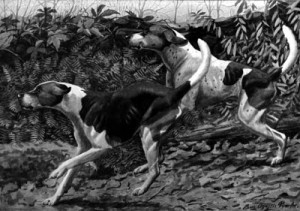What’s the 411 on Heartworms?
According to the American Heartworm Society the first description of heartworms in dogs was first published over 100 years ago in the US issue of The Western Journal of Medicine & Surgery. Heartworms in cats weren’t described until the 1920s. However, the parasite affects cats and dogs differently. In the cat, the heartworm will lodge itself in the lungs, as opposed to the dog that may harbor the parasite in both the lungs and the heart.
Also, on the American Heartworm Society website is a 2007 map showing areas of reported cases of heartworm. In the northeast, each state reported anywhere between 0 to 25 cases, and the highest incident of 26 to 100 reported cases were seen mostly in the warmer climate regions of the south-and-southeastern states. None of the reports indicated the degree of heartworm infestation in any individual cases, although the website writes it’s common to see 30 worms in an infected dog, and in extreme cases there may be as many as 100 to 300 adult worms. For the cat the number of worms is much lower, usually only 1 or 2, but not more than 6.
But should pet owners worry? Is the threat of heartworms really that serious? Dr. Kim Bloomer said, “Posted in the vet’s office are horrible pictures showing the adult heartworm infesting a heart and it’s just so scary. And that’s what it’s all about: FEAR.”
It’s not as easy as you think for your pet to get a heartworm infection. In the first place, all environmental conditions must be just right and the window of opportunity for an infection is very small.
Heartworms Life Cycle Explained
There are five stages in the heartworm’s life cycle: L1 to L5; and Stages 1 & 2 takes place in the mosquito. Let me explain: First, the mosquito itself must become infected and this happens when the insect sucks the blood of an animal that is already infected with adult heartworms and that’s only if the adult heartworms have mated and deposited larval into the bloodstream of the animal. Then the mosquito sucks in the larval and is now a carrier. Now, at this point a lot of things could happen. As the larval develops from L2 to L3 inside the mosquito, the outside temperature must remain above 57F degrees at all times. The minute the temperature drops below 57F degrees the larval stops developing and must start all over again. It is only at stage L3 that it can infect your pet.
Infection occurs when a mosquito carrying the larval, or L3 Stage, microfilariae, bites an animal. The mosquito doesn’t directly deposit the larval into the animal’s bloodstream. Instead, a droplet of saliva containing the larval is deposited next to the mosquito’s injection site. Then the larval swims towards the injection site and providing that the droplet doesn’t evaporate, or is washed off by a bath, or the rain, the larval will now enter the dog’s skin. The L3 larval will stay in the skin for 2 weeks before developing into the L4 stage. Then the L4 larval will spend 3 or 4 months in the skin as it develops into the L5 adult stage. At the L5 stage it leaves the skin and enters the bloodstream and migrates to the heart and lungs. After 5 or 7 months in theses organs the L5 will mate. However, there has to be a male and a female adult for reproduction to occur.
Heartworm Treatment
Conventional veterinarians treat heartworm with drugs. For prevention they may prescribe Ivermectin, a de-wormer made by Merek and is used to kill the lava, not the adult worm. And, like any drug there are side effects, such as: vomiting, diarrhea, thyroid problems, auto immune disorders, fever, weakness, dizziness, and coughing. Dr. Bloomer adds, “It [heartworm preventatives] has the most widely reported drug adverse reactions in animals; up to 65%.”
According to the American Veterinary Medical Association (AVMA) a minority of animals experience adverse drug reactions, but those that occur are seen in most breeds. The AVMA went on to say they have found that 65% of all drug reactions reported, and 48% of all reported deaths caused by drug reactions were from heartworm preventive medicine. ~ Lee Cullens, Woodhaven Labs.
MDR1 Gene Mutation In Dogs And Cats
In certain dog breeds the drug Ivermectin may cause seizures, or death. For example, Collies, and other herding breeds, are often afflicted with the multi-drug resistance MDR1 gene. The MDR1 is a mutation that encodes a protein responsible for pumping drugs and toxins out of the brain. When a dog has this gene these drugs and toxins will penetrate the brain’s blood barrier and cannot be pumped out and this can lead to serious neurological complications, and/or death.
NOTE: In 2024, Washing State University began a study to identify drugs dangerous to cats that have the MDR1 mutation. Up to 4% of all cats, approximately 4 million in the U.S. alone, have either one or two mutated copies of the MDR1 gene, which can make common medications, including those used for parasite control, potentially lethal, even when used at recommended dosages. Cats with two mutated copies – homozygous – are at increased risk of adverse reactions.
The study, led by Dr. Katrina Mealey, who initially discovered the MDR1 mutation and invented the first test to detect the condition, is specifically targeting cats that may have experienced a neurological adverse reaction to NexGard COMBO (eprinomectin), Centragard (eprinomectin), Profender (emodepside), Revolution (selamectin) or Cisapride (compounded formulation). See REPORT.
Adverse Reactions To Heartworm Meds
Recently, the Companion Animal Parasite Council (CAPC) has reported an increased resistance to canine heartworm prevention drugs. According to Dr. Karen Becker DVM, she feels it’s due to these drugs being over-prescribed and overused.
If the heartworm has reached the adult stage there’s only one FDA approved canine treatment and that’s the arsenical drug, Melarsomine, which is the active ingredient in Immitcide. Adverse reactions are: May cause pulmonary thromboembolism 7 to 20 days after therapy, injection site reactions (Myositis), lethargy, difficult breathing, coughing, loss of appetite (anorexia), fever, and vomiting. But, keep in mind, there is a low margin of safety with Melarsomine. Overdose complications (pulmonary inflammation or death) can occur if an incorrect dose is given.
Note: Cats have a lower susceptibility to heartworm infestation, but when they are infected, the worms are fewer in number, are usually single-sex, thus, unable to reproduce, and do not survive for nearly as long as they do in canine infection. However, The Heartworm Society states that a “small worm burden” may be potentially fatal for cats. There is no adult heartworm treatment for cats. Instead, it’s suggested to allow the infection to take its natural course to a spontaneous cure. For more information on heartworm in cats, click HERE.
Natural Prevention of Heartworms:
There is a natural way to protect your dogs from heartworms. And one of the best ways to protect your pet is for them to have a strong immune system, and a strong immune system is achieved through proper nutrition. That’s why I’m so adamant about feeding our dogs and cats a raw meaty bone diet full of live enzymes and natural probiotics.
In the wild, you don’t see wolves, foxes, and coyotes, dropping dead from heartworm infestation. I’m not saying wild animals don’t get parasites. Of course, they do. But they don’t have the infestations the way our domesticated dogs do. Here is an interesting study:
In a 1991-1996 disease testing study of live-captured wolves in Wisconsin, heartworm infection was found to be very rare. In another study published in the Journal of Wildlife Diseases, showing that 920 coyotes, “harvested by hunters and trappers” in Illinois from 1995-97 had an incidence of heartworm of only 16% statewide. In addition, of those infected, neither body weights nor fat reserves were impacted by the presence of the worms. While coyote populations increased significantly in the 20 years prior to the study (in 2003), the prevalence and intensity (the number of worms per individual) of heartworm infections appears to have changed only a little. The conclusion of the research: heartworm disease is only a minor factor influencing the population dynamics of this wild canid species. ~ Will Falconer, DVM
Another study states: Trapped coyotes, and red and gray foxes were found to have the following incidence of heartworms:
• 7% of 293 coyotes had the worms
• 6% of 85 red foxes did
• 0% of 70 grey foxes
None of the above wild animals were either incapacitated by—or, died from—heartworms. So, what are wolves, foxes, and coyotes doing right that domesticated dogs aren’t doing right? After all, wolves and foxes live outside surrounded by millions of mosquitoes 24/7. Well, wild animals have plenty of fresh air, exercise, no vaccines, no drugs, and they eat fresh, raw meat. In other words, the dog’s wild cousin has a stronger immune system ready to attack any foreign invaders.
So what’s wrong with our dogs? I blame our pets’ diet of ultra-processed commercial pet food as the main culprit. Plus, the use of antibiotics, vaccines, steroids, toxic topical flea & tick products, heartworm medications, a sedentary life, stress, all of which, weaken the immune system of the animal.
Parasites are part of Nature. It’s not the goal of the parasite to kill its host, but to live in harmony with the animal’s immune system. When the animal’s immune system is not optimal, the body becomes out of balance and the parasites take over. Keep in mind, animals have parasites because they are sick or in a susceptible state. This is Nature’s way of weeding out the weak.
But, if you’re still worried…
Let’s work on keeping mosquitoes away from the dog & cat by using natural repellents:
Lemon eucalyptus oil:
The most effective natural mosquito repellent at the time of writing is Repel Lemon Eucalyptus.
A 2002 study in the New England Journal of Medicine compared different synthetic chemical and herbal repellents: Repel Lemon Eucalyptus Repellent provided 120.1 minutes of mosquito protection, more than a repellent with a low concentration of the chemical DEET (Off Skintastic for Kids with 4.75% DEET provided 88.4 minutes of protection) and less than Off Deep Woods with 23.8% DEET, which provided 301.5 minutes of protection.
A study by the US Department of Agriculture compared four synthetic mosquito repellents and eight natural mosquito repellents and found that Repel Lemon Eucalyptus was the most effective repellent, more so than a 7% DEET repellent.
Lemon eucalyptus oil repellents, in addition to the chemicals DEET and picaridin, have been registered with the U.S. Environmental Protection Agency (which means that the materials have been reviewed and approved for effectiveness and human safety) and recommended by the Centers for Disease Control and Prevention (CDC) for mosquitoes that may carry the West Nile virus.
A June 2006 Consumer Reports article stated that after conducting their own tests, Repel Lemon Eucalyptus was the best non-DEET mosquito repellent. However, volunteers criticized its odor.
Essential Oils:
Essential Oils that have been known to repel mosquitoes, are Clove, Fennel, Thyme, Celery Extract, and Neem. Supposedly, protection is good up to approximately 90 minutes. However, clove and thyme are irritates and must be diluted using a carrier-oil before use.
NOTE: If you’re going to use essential oils to make bug repellents, please use therapeutic oils, not the junk that is sold at supermarkets, department stores, or even Natural Food shops.
A WORD OF WARNING IF YOU’RE GOING TO USE ESSENTIAL OILS (EO) ON CATS: You really need to know what you are doing when applying EOs on a cat. Cats have a more sensitive liver than dogs. Therefore, all EOs must be a therapeutic brand and must be diluted.
Also:
If your area is experiencing a high mosquito infestation, brush your dog or cat daily to knock off any mosquito “spit” that may have been deposited on the dog/cat. Also, mosquitoes are more prominent at dusk, so you may want to keep your pets indoor at this time of day.
A good natural product to help keep your yard, or garden, free of mosquitoes is Mosquito Barrier. It’s made from a potent variety of garlic bulbs, which contains a natural sulfur that repels & kills ticks, fleas, and mosquitoes, but safe for bees and butterflies.
I’m going to mention this again because it is important: The best defense against pests & parasites is a strong, healthy immune system. This is achieved by feeding your cat or dog a species appropriate diet. Ultra-processed pet food makes their blood sweet, and pests and parasites love sweet blood. But, when your carnivore pet is on a raw meaty bone diet it gives their blood a bitter taste which is repulsive to fleas, ticks, and mosquitoes.
References
1. American Heartworm Society
2. “Natural Heartworm Prevention & Treatment,” by Dr. Jeannie Thomason, wholedog.org
3. Busteralert.org, “Mini Aussie Rescue & Support”
4. “Healthy Pets” Healthypets.Mercola.com. “The Mosquito Borne Super-Worm Is Soaring in the US,” June 16th, 2011
5. MosquitoBarrier.com












